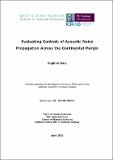| dc.contributor.advisor | White, Martin | |
| dc.contributor.author | Daly, Eoghan | |
| dc.date.accessioned | 2021-09-07T09:02:26Z | |
| dc.date.available | 2021-09-07T09:02:26Z | |
| dc.date.issued | 2021-08-23 | |
| dc.identifier.uri | http://hdl.handle.net/10379/16906 | |
| dc.description.abstract | The ocean’s ability to transmit underwater sound efficiently over long distances enables anthropogenic noise as a cause of pollution in the global ocean. Ever increasing noise from sources such as sonar, seismic surveys, shipping and piledriving, hold the potential to adversely impact on the surrounding marine environment or ‘acoustic habitat’ to varying degrees. This project quantifies and characterises sound transmission across the continental margin and gauges physical controls on propagation. This allows for assessment and understanding of the processes and potential for noise pollution to impact on marine fauna around sensitive margin ecosystems. A desk study of an industrial seismic survey in the Porcupine Basin was conducted, while acoustic model capacity (2D) and feasibility (3D) have been explored. An offshore experiment was implemented on the eastern margin of the basin to evaluate, compare and contrast propagation along and across a small submarine canyon and adjacent slope. An array of five short-term fixed acoustic and hydrographic moorings were deployed over the study area from depths of 900 - 250 m and a controlled seismic sound source was deployed in a transect around the survey site. All measured data were processed, analysed and examined in the context of assessing physical processes, controls and damage thresholds or disturbance to marine life. Results from these studies and subsequent acoustic modelling identified range from source, slope angle, topography and water column structure as moderators of human noise propagation. Canyon geomorphology was found to enhance noise internally and across margin in both directions, e.g., up to 10 dB re:1μPa zero-to-peak and 4 dB re:1μPa2s SEL (upslope). Seismic airguns, and for the first time bottom trawling, have been confirmed as noise polluters in the Irish offshore, exhibiting levels of concern to marine wildlife. Findings reported herein, inferring that noise could cause damage or disturbance to resident or transient marine mammals along the Irish margin, especially around ecologically diverse canyon hotspots, underline the requirement for regulatory management within Ireland under various European directives, with obligations to monitor ocean noise and enforce mitigation strategies to tackle this pollution source. Key findings and future work planned from this project are intended to align with governance and monitoring initiatives regionally and within the Irish offshore sector. The motivation being to highlight and address anthropogenic noise as a detrimental stressor on a marine environment already under considerable and growing pressure from a multitude of human impacts, including microplastics, ocean acidification and global climate change. | en_IE |
| dc.publisher | NUI Galway | |
| dc.rights | Attribution-NonCommercial-NoDerivs 3.0 Ireland | |
| dc.rights | CC BY-NC-ND 3.0 IE | |
| dc.rights.uri | https://creativecommons.org/licenses/by-nc-nd/3.0/ie/ | |
| dc.rights.uri | https://creativecommons.org/licenses/by-nc-nd/3.0/ie/ | |
| dc.subject | Ocean noise pollution | en_IE |
| dc.subject | Continental margin | en_IE |
| dc.subject | Sound propagation | en_IE |
| dc.subject | Behavioural disturbance | en_IE |
| dc.subject | Marine Mammals | en_IE |
| dc.subject | Bottom trawling | en_IE |
| dc.subject | Offshore seismic surveys | en_IE |
| dc.subject | Science and Engineering | en_IE |
| dc.subject | Earth and Ocean Sciences | en_IE |
| dc.subject | Natural Sciences | en_IE |
| dc.title | Evaluating controls of acoustic noise propagation across the continental margin | en_IE |
| dc.type | Thesis | en |
| dc.contributor.funder | Irish Centre for Research in Applied Geosciences | en_IE |
| dc.contributor.funder | Science Foundation Ireland | en_IE |
| dc.contributor.funder | European Regional Development Fund | en_IE |
| dc.contributor.funder | PIPCO RSG | en_IE |
| dc.contributor.funder | Irish Research Council | en_IE |
| dc.local.note | Human noise in the ocean, from shipping, construction and exploring for oil and gas, can be harmful for the ocean environment, especially marine mammals. This work investigates underwater human noise from seismics surveys and trawl fishing to greater understand how it might effect marine wildlife in Irish waters. It finds that settings like submarine canyons, where the deep ocean meets the shallower shelf seas, are particularly noisy and therefor need further regulation in order to protect the marine environment and the life it holds. | en_IE |
| dc.local.final | Yes | en_IE |
| dcterms.project | info:eu-repo/grantAgreement/SFI/SFI Research Centres/13/RC/2092/IE/Irish Centre for Research in Applied Geosciences (iCRAG)/ | en_IE |
| nui.item.downloads | 66 | |


